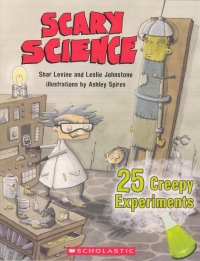| ________________
CM . . .
. Volume XVII Number 5. . . .October 1, 2010 
 |
Scary Science: 25 Creepy Experiments.
Shar Levine & Leslie Johnstone. Illustrated by Ashley Spires.
Toronto, ON: Scholastic Canada, 2010.
56 pp., pbk., $6.99.
ISBN 978-0-545-98030-2.
Subject Heading:
Science-Experiments-Juvenile literature.
Grades 2-7 / Ages 7-12.
Review by Barbara McMillan.
**** /4
|
| |
|

excerpt:
This book won't teach you to become a witch or wizard. It won't turn you into a ghost, ghoul or goblin, but it will help you to amaze your friends and wow your parents. Now, don't tell a soul (living or dead), but you won't be using any magic or conjuring up creatures; you will be using science to perform some very remarkable spooky feats.
"Dynamic duo" is a an expression that has commonly been associated with Batman and Robin, but, in the science literature for children and adolescents, it could just as well describe Shar Levine and Leslie Johnstone who are the co-authors of more than 55 creative and engaging books promoting science. They consistently invite their readers to carry out experiments and scientific investigations so that they come to understand how science is prevalent in their out-of-school lives and useful in explaining phenomena that may first appear strange or baffling.
With titles like "Shrunken Heads", "Bubbling Alien Blood", "Bouncing Eyes", "Exploding Stomach", and "Ghost Legs", the 25 activities in Scary Science are certain to appeal to boys and girls with interests in the supernatural and "stuff" considered eerie or simply gross. If the titles aren't sufficient to entice all readers, Levine and Johnstone introduce each activity with several informative sentences that link the title to the activity and encourage readers to explore. A good example of this is Activity 15, "Vampire Bites":
Despite the popularity of all things vampire, people who are "creatures of the night" do not exist. That is not to say there aren't vampires. There are vampire bats whose main source of food is blood. And there are people who have a condition called photosensitivity who cannot go out in the sun and must live their lives in the shade. But here's a way to look like a vampire.
Scary Science, like Silly Science and Everyday Science, gives directions for activities that use materials commonly found in the home and school. This fact will please parents and teachers who may only have to borrow or purchase Alka-Seltzer tablets, citric acid, a bar of Ivory soap, 60 cm of PVC pipe, guar gum, Borax, glycerin, and a black light. All necessary materials for an activity are listed under the section heading "You Will Need", and where a material is uncommon, like citric acid, there is a suggestion for where it is likely to be found and purchased (e.g., with canning supplies" or "at a hardware store").
Clear, step-by-step directions for each activity are provided in the section "What to Do." Some of these steps include questions that guide observations while others suggest how to dispose of the created materials or reiterate the safety concerns (e.g., "wash your hands"; "do not swallow", "stand back") identified in the "Warning to Young Scientists" and "Note to Parents and Teachers" in the introduction to the book.
The artist, Ashley Spires, uses a boy and a girl, a scientist, a laboratory assistant, and an assortment of ghosts, goblins, and aliens to illustrate the activities in Scary Science. The scientist is a cross between Dr. Frankenstein (the mad scientist portrayed on the book's cover) and Dr. Einstein. He is drawn having unkempt and spiky grey hair, bushy grey eyebrows, oversized safety glasses, and a white lab coat. His hesitant assistant is clearly a depiction of Igor, the devoted hunchback in several Frankenstein films. These characters fit well with the gross and spine-chilling contexts in which the activities are presented even though they tend to reinforce the mad scientist persona.
What makes Scary Science especially valuable are the two components of each activity that provide a scientific explanation for what happened and tie the components or product of the activity to a real world event or phenomenon. One example of this is found in Activity 4, "Festering Ooze.". With adult help, readers are to combine specific amounts of white glue, yellow or green food colouring, glycerine, borax and water. Doing so creates a material that looks like a slimy pus. But why do these four liquids and one powder (borax) make a runny or less runny and bouncy semi-solid? It all has to do with the polyvinyl alcohol in the glue and the chemical reaction that occurs when the glue is mixed with the borax-water solution and long chains of molecules called polymers are formed. In the "Strange…But True" section, readers learn why glue sticks to some materials but doesn't stick to the inside of the bottle that contains it.
I highly recommend Scary Science: 25 Creepy Experiments to parents and teachers of children who are fascinated by chemical and physical changes and to parents and teachers who know of students who just might become more interested in science if presented using the weird contexts for investigation described by Levine and Johnstone.
Highly Recommended.
Barbara McMillan is a teacher educator and a professor of science education in the Faculty of Education at the University of Manitoba in Winnipeg, MB.

To comment
on this title or this review, send mail to cm@umanitoba.ca.
Copyright © the Manitoba Library Association. Reproduction for personal
use is permitted only if this copyright notice is maintained. Any
other reproduction is prohibited without permission.
NEXT REVIEW |
TABLE OF CONTENTS FOR THIS ISSUE
- October 1, 2010.
AUTHORS |
TITLES |
MEDIA REVIEWS |
PROFILES |
BACK ISSUES |
SEARCH |
CMARCHIVE |
HOME |
